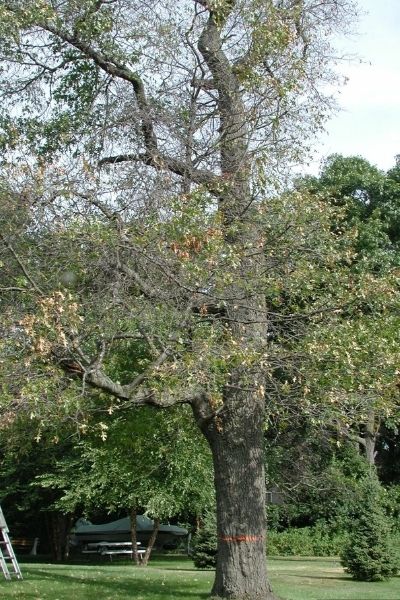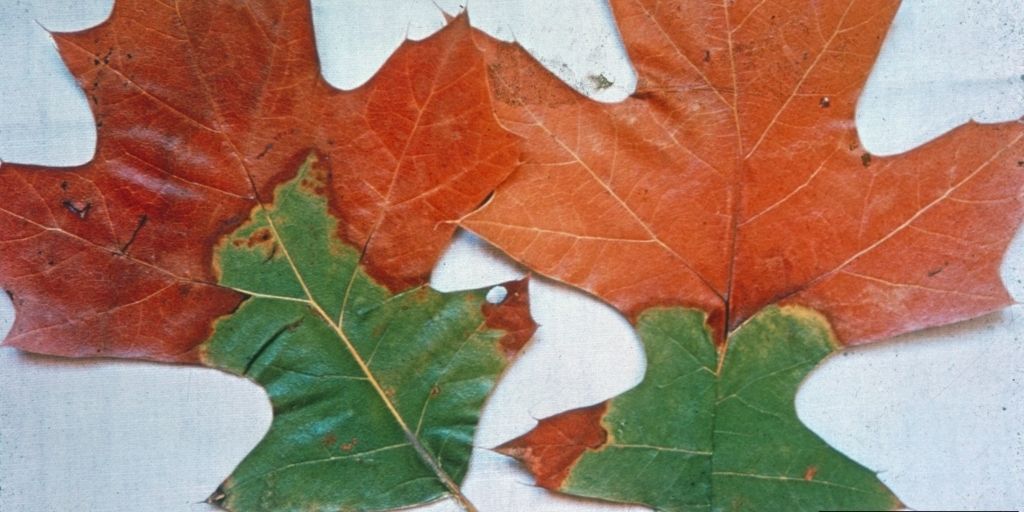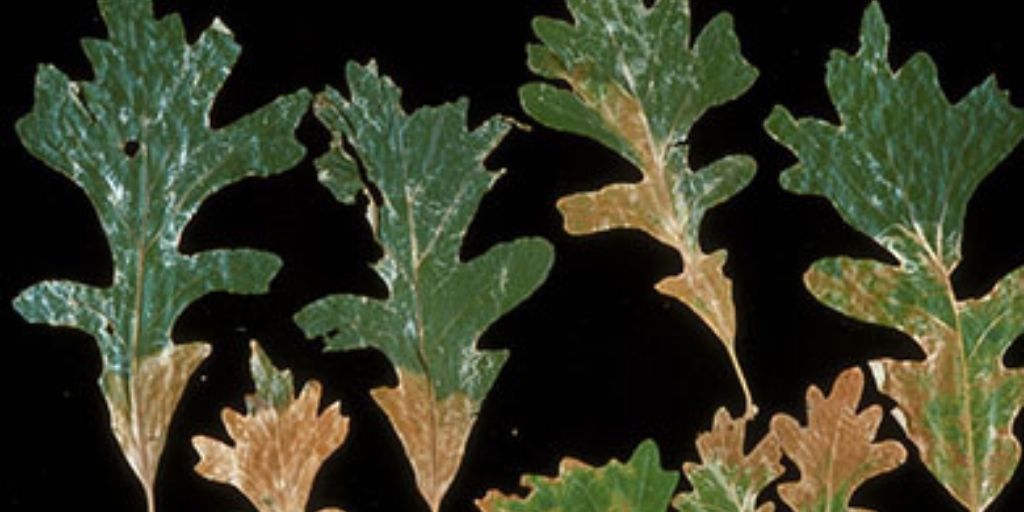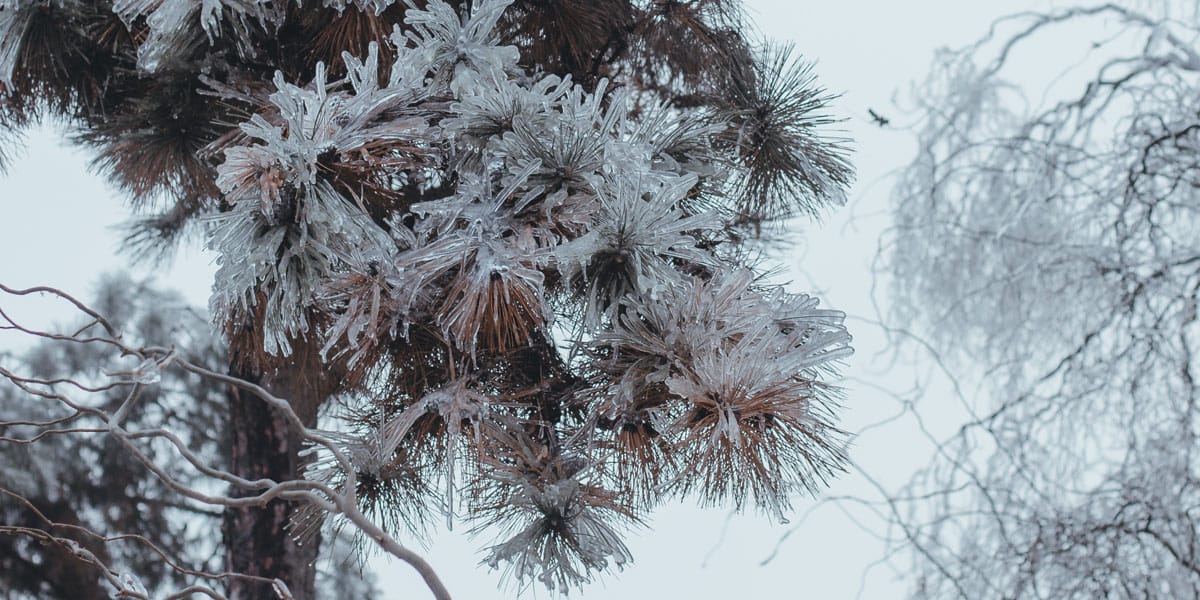Oak wilt is a fatal disease that kills oak trees within a few years of infection. As of mid-2021, oak wilt has not yet been confirmed in New Jersey (although there have been newspaper reports of infected trees, the experts at Rutgers tell us there are no confirmed cases). However, oak wilt has been found in neighboring states, with confirmed infections as close a Brooklyn and Long Island. It’s only a matter of time before our oak trees are at risk from this devastating disease that has killed millions of magnificent oaks from Texas and South Dakota all the way east to New York.
In these FAQs, you’ll learn how to recognize the symptoms of oak wilt infection, when to look for it, and how it spreads. Better yet, you’ll learn how to prevent oak wilt from spreading to infect your and your neighbors’ trees. With a few simple preventive actions, it is possible to protect your oak trees and stop oak wilt from killing them.

Oak wilt symptoms.
Joseph OBrien, USDA Forest Service, Bugwood.org
What is oak wilt?
Oak wilt is an incurable, deadly fungal disease that affects oak trees (Quercus species). Oak wilt spreads by a fungus, Ceratocystis fagacearum, that’s carried by beetles. The disease develops in the tree cells that send water to all parts of a tree (the xylem), blocking the passage of water and causing the tree to wilt and die.
Oaks make up a third of our forest trees, so their loss would drastically change the look of New Jersey’s forests. The habitat and food that wildlife gets from oaks is a vital resource and underscores how important it is to slow the spread of oak wilt.
Does oak wilt kill all types of oak trees?
New Jersey is home to many oaks, and the spread of oak wilt threatens all of them. We have 17 species of native oaks, including:
- Bear oak (Quercus ilicifolia)
- Black oak (Quercus velutina)
- Blackjack oak (Quercus marilandica)
- Chestnut oak (Quercus montana)
- Dwarf chinquapin (Quercus priniodes)
- Northern red oak (Quercus rubra)
- Overcup oak (Quercus lyrata)
- Pin oak (Quercus palustris)
- Post oak (Quercus stellata)
- Scarlet oak (Quercus coccinea)
- Southern red oak (Quercus falcata)
- Swamp chestnut oak (Quercus michauxii)
- Swamp white oak (Quercus bicolor)
- White oak (Quercus alba)
- Willow oak (Quercus phellos)
While you won’t find all of these oak species in the area around Madison or Morristown, oaks throughout the state can contribute to oak wilt spread in our area.

Symptoms of oak wilt on black oak (Quercus velutina) leaves showing bronzing starting at the leaf tips and lobes, with a green area at the stem. Photo courtesy of C.E. Seliskar, bugwood.org.
What are the signs of oak wilt infection?
You probably won’t see the beetles that spread oak wilt (they’re only 1/8” to ¼” long). But you can definitely see signs that oak wilt has infected a tree. In New Jersey, you’ll start to see oak wilt symptoms in July, including:
- Leaf discoloration, beginning with an off-green color
- Wilting leaves, starting at the top of the tree and quickly moving downward
- Leaves browning at the margins and looking “scorched”
- Bark cracks
- Fungal growth under oak bark (mostly in red oaks)
- A fruity smell
- Leaf drop and defoliation (red oaks, especially, will drop all of their leaves by early August)
- Brown streaks in the growth rings (visible when a tree is cut down and more common in white oaks)
By the time you see these symptoms, the oak tree is already declining and cannot be saved. A red oak can die within weeks of becoming infected by oak wilt.
Oak wilt symptoms are often confused with similar signs of bacterial leaf scorch (BLS). However, BLS symptoms generally appear later in the summer, often during a 2 to the 3-week period in August. A tree infected with oak wilt also dies more quickly than those affected by bacterial leaf scorch.
The only way to confirm that a tree is infected with oak wilt is to have tissue samples tested in a laboratory.
Is oak wilt found in central New Jersey or near Madison, NJ?
In 2019, more than 40 oak trees around Horseshoe Lake in Succasunna were thought to have oak wilt and were removed. However, a later investigation by the experts at Rutgers and the New Jersey Forest Service confirmed that the trees near Roxbury were not infected with oak wilt. Instead, the symptoms were caused by the very similar (and also fatal) bacterial leaf scorch and/or oak decline.
As of this date, there are no confirmed cases of oak wilt in New Jersey. However, experts suspect that it’s already here – it just hasn’t yet been confirmed.

White oak leaves showing the typical scorched look caused by oak wilt infection. Photo courtesy of Fred Baker, bugwood.org.
Are some oaks more susceptible to oak wilt than others?
While all oak species are susceptible to oak wilt, oaks in the red oak group (such as pin oaks and Northern red oaks) die faster than white oaks (including chestnut oaks and white oaks).
- A red oak can die from oak wilt within six months.
- White oaks can take a year or more to die.
White oaks also spread the disease more slowly than red oaks.
You can tell the difference between red oak species and white oak species by their leaf shapes:
- Red oaks have pointed leaf tips
- White oaks have rounded leaf tips.
NOTE: In addition to being beautiful, our treasured Northern red oak (Quercus rubra) is the state tree of New Jersey.
How does a tree get oak wilt?
Oak wilt spreads in two ways: above ground and below ground.
Above-ground Spread of Oak Wilt
The oak wilt fungus is spread above ground by two types of beetles, as well as by humans.
Sap Beetles
Nitulid beetles, or sap beetles, are attracted to oak trees by the smell of sap. This can be from fresh pruning cuts or by fresh breaks in branch or trunk wood from storms or other accidental tree damage.
The smell of oak wilt infection in trees also attracts sap beetles. The beetles feed on the infected sap and then carry oak wilt spores from an infected tree to a healthy one.
Oak Bark Beetles
These bark beetles eat the new bud growth on oak twigs. On a healthy oak, they first eat leaf buds and then chew into twigs or under the bark to nest.
When a bark beetle carries spores of oak wilt fungus from an infected tree to a healthy one, it spreads the fatal disease.
Cutting and Moving Firewood
You can spread oak wilt by moving firewood. When you chop up infected oaks for firewood and move the wood to an area with no existing oak wilt, you spread the disease.
Sap beetles will arrive, attracted by the scent of the fungus, and spread it to nearby trees.
There are firewood quarantines in areas in which oak wilt has been found. Always abide by those firewood quarantines!
Pruning at the Wrong Time of Year
If you prune your oaks in spring or summer, instead of during winter dormancy, you leave wounds wide open to sap beetles and oak wilt (and plenty of other diseases and pests).
Open wounds from spring pruning cannot seal off fast enough to keep out the disease. This is another reason to always have your oak trees pruned during the dormant season.
Below-ground Oak Wilt Spread
Oak wilt spreads between oaks through their intertwined root systems.
Roots from oaks grow out into the soil and join up (or graft together) below ground, making a large communal network.
This grafting connects the roots and the trees’ vascular systems. An infected root can then transmit oak wilt to a neighboring, healthy oak tree.
When does oak wilt spread?
Oak wilt spreads most readily in the spring after trees emerge from dormancy, and when insects and diseases are active.
Oak wilt moves into the xylem cells and grows into a plug that stops up the tree’s water system. The tree’s own defense method reacts by sealing off the infected area, closing off more water channels.
You will see symptoms of oak wilt appearing in summer, but summer’s high temperatures and periods of dry weather stop or slow the fungus’s growth (it will begin again with cooler temperatures). There is still a risk, however, that the disease can spread in summer and fall. That’s why we recommend taking the cautious approach and only pruning oak trees between mid-October and early April.
Can a tree recover from oak wilt?
There is no cure for oak wilt disease and no treatment. Once oak wilt infects an oak tree, there’s no way to stop the tree from dying.
Treating healthy oaks with a systemic fungicide for oak wilt can prevent infection. Systemic treatment protection is temporary, however, and the cost of treating and re-treating lots of oaks can be prohibitive.

Injection with a systemic fungicide can help to protect healthy oak trees from being infected with oak wilt. Photo courtesy of Joseph O’Brien, USDA Forest Service, bugwood.org.
Can I prevent or slow the spread of oak wilt?
While there is no cure for oak wilt, there are things you can do to slow the disease’s spread and protect healthy oaks.
Don’t Prune Your Trees During the Growing Season
Only prune your oak trees during winter. Winter pruning prevents disease spread.
A good rule of thumb is to avoid pruning or injuring your oaks from early April to October.
Avoid Damaging Your Tree’s Bark
Don’t climb, or let anyone else climb, any (living) trees with spikes. Spikes are designed to sink into tree bark, and the holes they leave are perfect openings for insects and diseases to attack your tree.
Keep lawn mowers and string trimmers away from oak trees. And don’t hang hammocks, swings, or anything else in an oak that could damage the bark.
Keep Your Pruning Tools Clean
Disinfect your tools before starting work, as well as when you’re done. You should clean every tool that you use on an oak tree. You can use bleach diluted in water to 1:10 or use rubbing alcohol.
If you work with others or share tools, make sure everyone does this.
Treat Firewood Responsibly
Oak firewood can harbor oak wilt fungus after the tree is dead. If you have firewood with bark on it, store the firewood in a sunny, dry area, and wrap it tightly with a tarp.
Make sure you weigh down the edges of the tarp and cover any holes. Any sap beetles that are under the bark won’t be able to escape a fully wrapped pile. Leave the wood wrapped for at least a year.
Most importantly, don’t transport firewood to areas in New Jersey that don’t have any oak wilt.
Use Professionals to Remove Trees
New Jersey recognizes the difference between trained, certified arborists and landscapers, and so should you.
Tree removal is dangerous and exacting work, and with oak wilt, it’s even more vital to hire skilled professionals to remove them.
This is because of the oaks’ intertwined root system. When you remove an oak that has its roots connected to other oaks, the oak wilt fungus can move into those connected trees.
To prevent this, connected roots have to be cut. This complex work should be done only by trained, experienced arborists who follow all safety and sanitation practices.
What should I do if my tree has oak wilt?
Don’t try to prune your oak trees yourself. We encourage homeowners to learn how to properly prune their trees but not in the case of oak wilt.
If you think you’re seeing oak wilt disease on your trees, call us right away. Oak wilt won’t get better, and it will spread to other oaks and kill them.
We can help with expert advice and professional tree removal, as well as with preventive treatments for your healthy oak trees.





